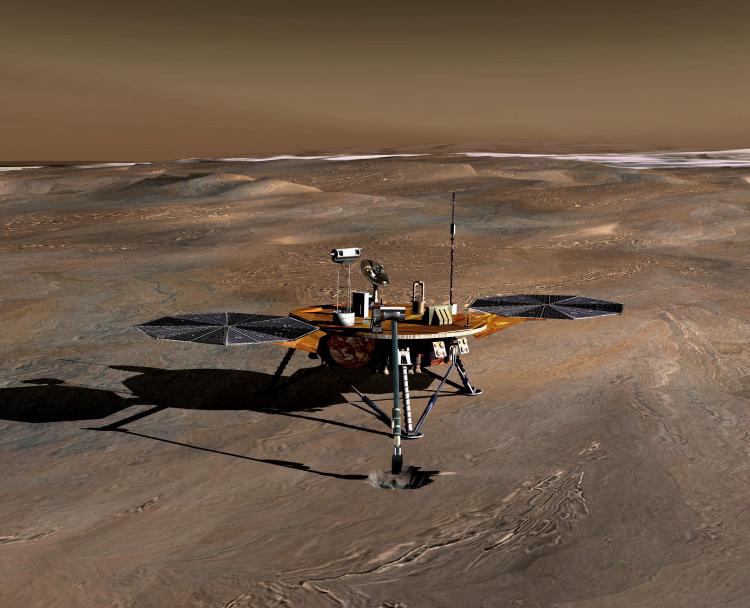NASA declared that operations for its Phoenix Mars lander have ended. Following repeated unsuccessful attempts to contact the spacecraft—and a new image from the Mars Reconnaissance Orbiter (MRO) revealing signs of severe ice damage to the lander’s solar panels—NASA has concluded that the Phoenix mission is officially over.
NASA admits that Phoenix was not designed to survive the dark, cold Martian winter. Yet the agency still held some hope that the craft may have survived; so it began attempts to listen for the lander after abundant sunshine returned to the red planet.
Last week, NASA’s Mars Odyssey orbiter flew over the Phoenix landing site 61 times in a last ditch effort to communicate with the craft, but failed to make contact. This followed 150 flights in three earlier listening campaigns this year that produced similar results.
A recent photo added further evidence of Phoenix’s demise. The MRO image of Phoenix taken this month by a special high-resolution camera on board the spacecraft suggested the lander no longer casts shadows the way it did during its working lifetime. Apparent changes in the shadows cast by the lander are consistent with predictions of how Phoenix could be damaged by the harsh conditions of a Martian winter. It was anticipated that the weight of a carbon-dioxide ice buildup could bend or break the lander’s solar panels, destroying its power supply.
“The Phoenix spacecraft succeeded in its investigations and exceeded its planned lifetime,” said Fuk Li, manager of the Mars Exploration Program at NASA’s Jet Propulsion Laboratory in Pasadena in a press release. “Although its work is finished, analysis of information from Phoenix’s science activities will continue for some time to come.”
The solar-powered lander completed its three-month mission and kept working until sunlight waned two months later. Earth-based research continues on discoveries Phoenix made during summer conditions at the far-northern site where it landed on May 25, 2008.
During its mission, Phoenix confirmed and examined patches of the widespread deposits of underground water ice detected by Odyssey and identified calcium carbonate—suggesting the occasional presence of thawed water. The lander also found Martian soil chemistry with significant implications for life, and observed falling snow. The mission’s biggest surprise was the discovery of perchlorate, an oxidizing chemical on Earth that serves as food for some microbes and is poisonous to other forms of life.
NASA admits that Phoenix was not designed to survive the dark, cold Martian winter. Yet the agency still held some hope that the craft may have survived; so it began attempts to listen for the lander after abundant sunshine returned to the red planet.
Last week, NASA’s Mars Odyssey orbiter flew over the Phoenix landing site 61 times in a last ditch effort to communicate with the craft, but failed to make contact. This followed 150 flights in three earlier listening campaigns this year that produced similar results.
A recent photo added further evidence of Phoenix’s demise. The MRO image of Phoenix taken this month by a special high-resolution camera on board the spacecraft suggested the lander no longer casts shadows the way it did during its working lifetime. Apparent changes in the shadows cast by the lander are consistent with predictions of how Phoenix could be damaged by the harsh conditions of a Martian winter. It was anticipated that the weight of a carbon-dioxide ice buildup could bend or break the lander’s solar panels, destroying its power supply.
“The Phoenix spacecraft succeeded in its investigations and exceeded its planned lifetime,” said Fuk Li, manager of the Mars Exploration Program at NASA’s Jet Propulsion Laboratory in Pasadena in a press release. “Although its work is finished, analysis of information from Phoenix’s science activities will continue for some time to come.”
The solar-powered lander completed its three-month mission and kept working until sunlight waned two months later. Earth-based research continues on discoveries Phoenix made during summer conditions at the far-northern site where it landed on May 25, 2008.
During its mission, Phoenix confirmed and examined patches of the widespread deposits of underground water ice detected by Odyssey and identified calcium carbonate—suggesting the occasional presence of thawed water. The lander also found Martian soil chemistry with significant implications for life, and observed falling snow. The mission’s biggest surprise was the discovery of perchlorate, an oxidizing chemical on Earth that serves as food for some microbes and is poisonous to other forms of life.







